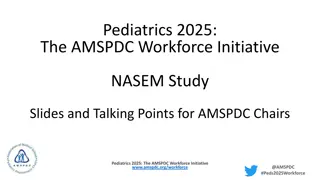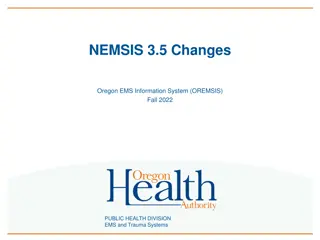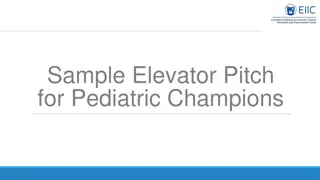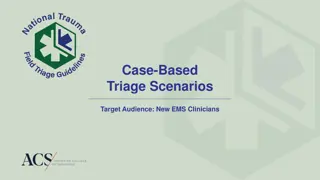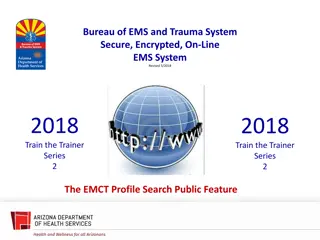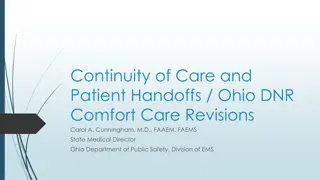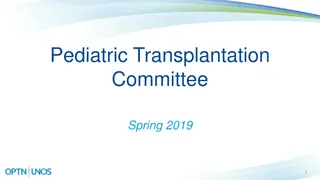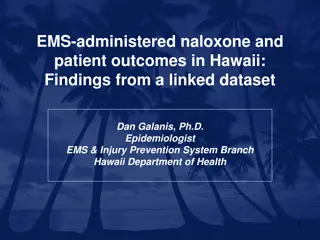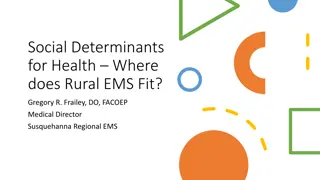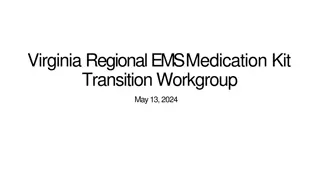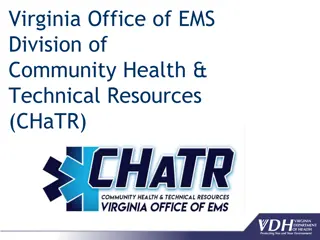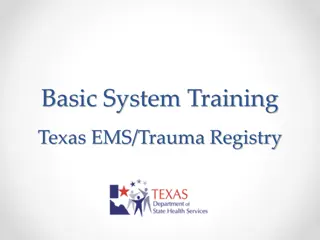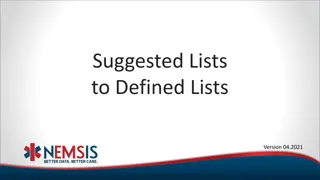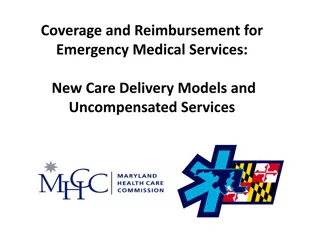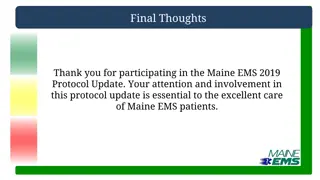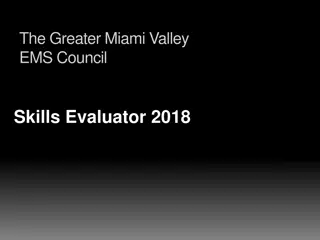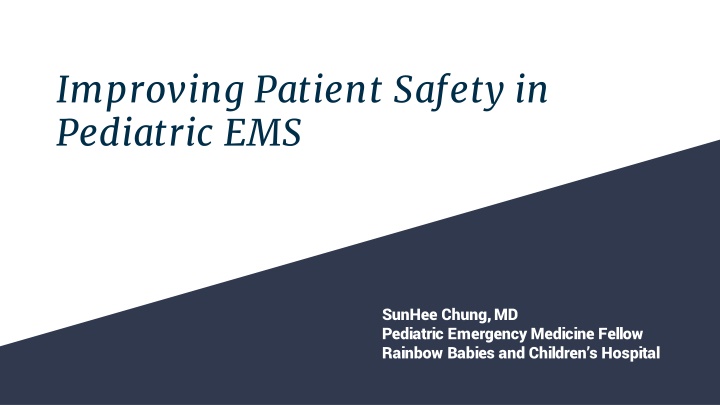
Enhancing Pediatric Patient Safety in EMS: Insights and Strategies
Explore the landscape of pediatric EMS patient safety, from defining patient safety to understanding the incidence of errors and reporting systems. Discover the challenges and opportunities to improve patient outcomes in pediatric emergency care.
Download Presentation

Please find below an Image/Link to download the presentation.
The content on the website is provided AS IS for your information and personal use only. It may not be sold, licensed, or shared on other websites without obtaining consent from the author. If you encounter any issues during the download, it is possible that the publisher has removed the file from their server.
You are allowed to download the files provided on this website for personal or commercial use, subject to the condition that they are used lawfully. All files are the property of their respective owners.
The content on the website is provided AS IS for your information and personal use only. It may not be sold, licensed, or shared on other websites without obtaining consent from the author.
E N D
Presentation Transcript
Improving Patient Safety in Pediatric EMS SunHee Chung, MD Pediatric Emergency Medicine Fellow Rainbow Babies and Children s Hospital
Definition of Patient Safety WHO Absence of preventable harm to a patient during the process of health care and reduction of risk of unnecessary harm associated with health care to an acceptable minimum IOM The prevention of harm to patients
Patient Safety Events (Medical Errors) Near miss? Adverse events?
In-hospital Errors in Pediatric Population 1.81 to 2.96 per 100 discharges Epidemiology are different from those of adults Children are at higher risk for bad outcomes
Pediatric EMS Each year, roughly 27.7 million (27% of total) of annual ED visits are by children About 2 million of these children reach the hospital via EMS Children who are transported via EMS more likely to be require immediate care and admitted to the hospital Transport time varies
Do Errors Exist in Pediatric EMS? Just like in hospital setting What is the incidence rate? Literature on patient safety and quality improvement less robust
Reporting Systems for Medical Errors FDA - Medwatch program EMS Safety Data System
Perceived Frequency of Medical Errors When surveyed about the past year, a. 35% of Emergency Medical Technicians (EMTs) reported making one or two errors and b. 9% reported making more than two errors J Pediatr. 2015 Patient safety Perceptions in Pediatric Out-of-Hospital Emergency Care: Children s Safety Initiative Guise et al.
EMS Provider Perceptions of Medical Errors 15 in-depth interviews Of total 61 events described, 27 (44%) were near-misses and 34 (56%) were adverse events 14 (23%) involved a child Society of Academic Emergency medicine 2008 Emergency Medical Services Provider Perceptions of the nature of Adverse Events and Near-misses in Out-of-hospital Care Fairbanks et al
Categories of Errors System level Team level Individual provider level Prehosp Emerg Care 2014 Understanding Safety in Preshopital Emergency Medical Services for Children Cottrell et al
Categories of Errors- System Level System level Medication and equipment Education and training Cultural norms
Categories of Errors- Team Level Team level Communication failure between team members Command and control issues Medical control, police, and fire Communication failure during transitions of care Lack of follow up Rarely any follow up from the hospital regarding the outcomes
Categories of Errors- Individual Provider Level Individual Provider Level Everything is harder. Period. History s harder, physical exam is harder. Treatments are harder. IV access is harder. Everything is harder. Pediatrics is a problem.
Categories of Errors- Individual Provider Level Individual Provider Level Overall heightened level of anxiety Experience and training in care of children Very high risk, very low frequency Assessment and decision making Technical and procedural skills
Specific Contributors to Patient Safety Events Pediatric airway management Medication dosing errors Equipment errors
Pediatric Airway Management Of 490 transports, 329 had a total of 338 airway management procedures (some had more than 1) 61.6 % treated with oxygen 15.3% with BVM 8.6 % ETT insertion 2% airway adjunct BMJ open 2016 Patient Safety Events in out-of hospital paediatric airway management Hansen M, et al
Pediatric Airway Management Overall, 27.8% (94/338) error 21% related to oxygen use 9.8% related to BVM 9.5% related to intubations 0.9% related to airway adjuncts 58% of intubations required 3 or more attempts or failed altogether
Pediatric Airway Management 58% of intubations required 3 or more attempts or failed altogether Over 70% of cases in which ETI was performed error of some type ETT placed too deep (25%) Incorrect size used (29%) Dislodgement of ETT during transport (13%) Reviewers felt that 24% of the time, ETI was not indicated when performed
Pediatric Airway Management The most common indication was cardiac arrest Time to epinephrine differed from 7 min to 11min
Severity of Airway Management Errors by Patient Age
Medication Dosing Errors Medication dosing error up to 17.8 % of hospitalized children Dosing Error defined >20% deviation from the weight-appropriate dose Albuterol, atropine, dextrose, diphenhydramine, epinephrine and naloxone Prehosp Emerg Care 2012 Medication dosing errors in pediatric patients treated by EMS Hoyle, et al
Medication Dosing Errors 5,547 chart review: 230 received drugs and had documented weight Total of 360 drug administrations 34.7% (125/360) had dosage errors Epinephrine highest at 60.9%
Medication Dosing Errors Electronic questionnaire to paramedics 1,043 responses 43 % were familiar with a medication dosage error by EMS 58.5% believed their initial paramedic program did not include enough pediatric training
In Summary Infrequency of encounter (5-10% of all runs) Greater anxiety of EMS providers Communication barriers Lack of reporting system Cultural norm Wide range of sizes of equipments Wide range of weight-based dosages of medications
EMS Provider Perceptions of Medical Errors A good paramedic wouldn t need to pull out a cheat sheet. It s a sign of weakness if you ask another paramedic on the scene what do you think? Almost all of the negative events I can recall over a 30- year-period in EMS have been in the ER. Society of Academic Emergency medicine 2008 Emergency Medical Services Provider Perceptions of the nature of Adverse Events and Near-misses in Out-of-hospital Care Fairbanks et al
Ways to Improve Weight-based tapes Standardized protocols Airway adjuncts Systemized hand-offs
Ways to Improve Changing the culture of blame and shame Standardized reporting system Standardized medicine and equipments More effective ways of training/education

